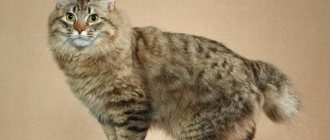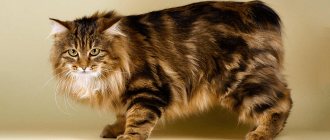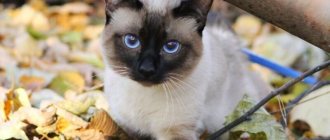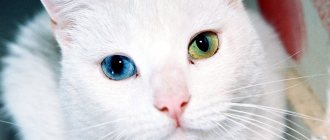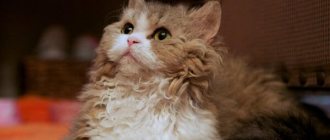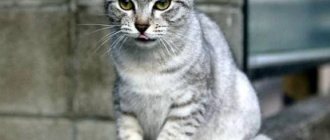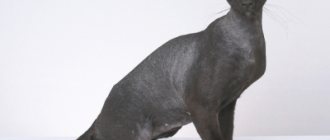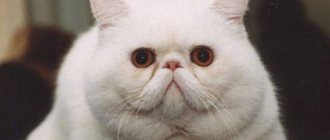History of the origin of the breed
The first cats sailed to Japan on merchant ships that sailed from India, through China to Japan. A huge number of legends and myths are associated with the cat breed called the Japanese Bobtail. And every year there were more and more stories about these representatives of the cat family.
It was believed that there was a deity appearing in the form of a cat named Nekomate, who was capable of bringing trouble to the people of Japan, and all his power was hidden in his tail. The period of famine began.
Cats were forcibly deprived of their tails by simply cutting them off. Thus, a new breed was gradually developed, called Maneki-neko, whose characteristic feature was precisely the absence of a tail.
It was only during the reign of Emperor Ichijo that the Japanese cat breed became officially considered domestic. Despite his fear of these animals, the ruler believed that taming these “demonic creatures” could strengthen his power by influencing the minds and hearts of his subjects.
Representatives of the calico-colored breed have become a symbol of happiness and prosperity.
In 1602, by decree of the emperor, animals became street animals and their main task was to catch and destroy rodents.
Since 1969, they began to spread throughout the world. At the end of the seventies, short-haired bobtails were officially recognized, and in the early nineties it was the turn of long-haired ones.
Noguchi Tetsuya. "A Samurai Walking His Cat" (Modern engraving)
Japanese cats lived a calm and measured life until the middle of the 20th century, namely until 1945. After the end of the war, the Allied occupation forces brought a huge number of new cat breeds to Japan, such as the Siamese and Persian, many of which are popular on the islands to this day.
Another interesting fact is that due to the urbanization that took place in Japan in the second half of the 20th century, many residents moved from their hometowns to cities, thus many cats went wild, and some of them even took over the entire island (Tashirojima): here There are about 8 cats per indigenous person.
About 150 cats live here on 3 square kilometers
Main features of Japanese cats
The main feature of Japanese cats, of course, is the short tail (pumpon tail). It is important to note that there is still a tail, albeit a short one, unlike tailless breeds (Manx and Cymric).
There are two reasons for the appearance of the bobtail, which is the name of the breed with a short tail. Firstly, in Japan, a cat with a long tail resembled a creature from ancient legends - Nekomata or the Cat with Two Tails. And secondly, a long cat’s tail was very dangerous in domestic conditions: stoves in houses were heated on the floor, and a cat could accidentally set fire not only to its tail, but to the entire house. This is why the Japanese prefer short-tailed cat breeds.
Another feature of Japanese cats is their short hair. Of course, in Japan there are a huge number of long-haired cat breeds, but short hair still predominates.
It is believed that the color of cats depends on their gender. For example, all-white cats (or predominantly white cats) are most often female. At the same time, cats in which orange or black colors predominate are usually males.
Japanese cat breeds
Japan does not boast a large number of cat breeds, unlike dogs, for example. However, there is something to see here too.
Japanese Bobtail
Short-tailed cats were not uncommon in Japan, but they gained worldwide recognition thanks to a young American named Judy Crawford. The thing is that, while in Japan in the 60s of the twentieth century, Judy was fascinated by the beauty and grace of unusual Japanese cats with a short tail. She sent two kittens as a gift to her friend - a boy and a girl, and when she returned home she found the newly arrived offspring. From then on, the breed began to spread throughout the world.
Japanese Bobtail with heterochromia (different colored eyes) - a common condition in all-white cats
The Japanese Bobtail is an unpretentious breed. Cats are endowed with a narrow body, pointed ears, and are distinguished by their paws that are often raised while sitting.
Kurilian Bobtail
Description and breed standard
Japanese Bobtail cats are not very large, their weight reaches about three kilograms for females, and four kilograms for representatives of the stronger sex.
There is an established breed standard, detailed by the TICA organization. They set the following description.
- The head should be shaped like an isosceles triangle with high cheekbones and a rounded chin.
- The eyes are large, oval, located at a slight angle, which is especially noticeable in profile.
- The body is slender and moderately long, with well-developed muscles.
- The paws are oval, harmoniously combined with the body, long and slender. Moreover, the hind limbs are clearly longer than the front ones.
- Most often, the tail has a straight shape, but there are also twisted, curved or pompom-shaped tails.
- The coat is of medium length and does not have a pronounced undercoat. You can find “knickers” on the paws.
- The most common colors are cats called "mi-ke" or "calico", which is characterized by black, red and white spots. Less commonly, individuals are black and have gray shades.
Care and maintenance
Japanese Bobtails have virtually no undercoat to protect them from the cold. Therefore, cats of this breed are very susceptible to drafts and low temperatures. To protect the Japanese from possible colds, they are provided with appropriate conditions and a warm, cozy place is arranged.
Hygiene procedures
In order for the Japanese Bobtail to have a neat appearance, it is provided with proper care:
Grooming
The Japanese Bobtail is perhaps the only cat breed that is not afraid of water. These animals love to bathe, but frequent bathing procedures can dry out their delicate skin. Therefore, the Japanese are washed no more than 3-4 times a year using special shampoos.
For short-haired bobtails, it is enough to brush them once a week. But long-haired representatives of the breed require daily care. Combing is done especially carefully during the molting period.
Tray
Japanese Bobtails are very clean cats; they quickly become litter trained. Any type of toilet is suitable for them, including a closed tray-house. As for the litter, it should not only cope with its functions, but also please the cat.
Japanese Bobtail tail
A characteristic feature of the Japanese Bobtail cat is its short tail. You can often find these cats without a tail at all.
The spinal column itself has numerous bends and breaks, which determines the uniqueness of each tail. But it is not only a pet’s decoration, but also its weak point, especially since it is very fragile and can easily be damaged.
The length of the tail is measured in two relaxed and straightened states. The maximum length when extended should be no more than 15 centimeters.
The fur on the tail is often longer than on the rest of the body, giving the tail a tassel or pompom-like appearance.
Reviews of the Japanese Bobtail
- Zlata.
The Japanese Bobtail is my favorite cat breed. This is a very smart animal, immediately understanding where to sharpen its claws and where to go to the toilet. The cat is very friendly with children; it has never happened that he bit or scratched a child. In the family, he singles out one “main” owner for himself. Adapts perfectly to any diet. I want to say that if you see a Japanese Bobtail, either in a photo or in person, you will not remain indifferent!
- Tatiana.
While choosing a cat, I saw a photo of a Japanese Bobtail and fell in love. I have a cat of this breed, kittens were recently born. I can say with confidence that all the characteristics described are completely identical.
Character
The Japanese Bobtail is a very energetic cat with a truly “explosive” character. They have a natural hunting instinct, which forces them to constantly hunt for mice and even flies.
Representatives of this breed get along well with other pets and children and are absolutely not afraid of dogs. But it is important to take into account that not every pet can handle a pet whose character is so passionate and active.
Fighting for attention, the Japanese Bobtail is able to follow its owner without leaving for a minute.
Due to their active nature and natural curiosity, cats often end up in places where they are not allowed access: a washing machine, a sideboard or a linen closet.
Japanese Bobtails love to play, and this is perhaps the only and most effective way to distract them from their pranks.
Personality of Japanese Bobtail cats
The Japanese Bobtail is a very energetic pet, far from the classic phlegmatic image of a cat. These short-tailed cats have a developed hunter's instinct, therefore, having such a pet, you will not see rodents or even insects in the house.
Cats love to be active, and without adequate exercise, your pet's behavior may worsen.
To curb the animal’s ardor, experts recommend walking it on a leash, offering various interactive toys, games with obstacles, and so on.
Japanese bobtails are very fond of children, and most often friendly relations arise between the cat and the child.
https://youtu.be/VmWjz-VqHL0
If there is another pet living in the house, it is worth thinking about the compatibility of the animals' temperaments.
The Japanese Bobtail is an owner-oriented pet. He doesn't just watch people, he learns. Get ready to find it in the most unexpected places, such as the top drawers of cabinets or the washing machine. The animal's lively mind and quick intelligence allows it to be taught any commands and numbers.

